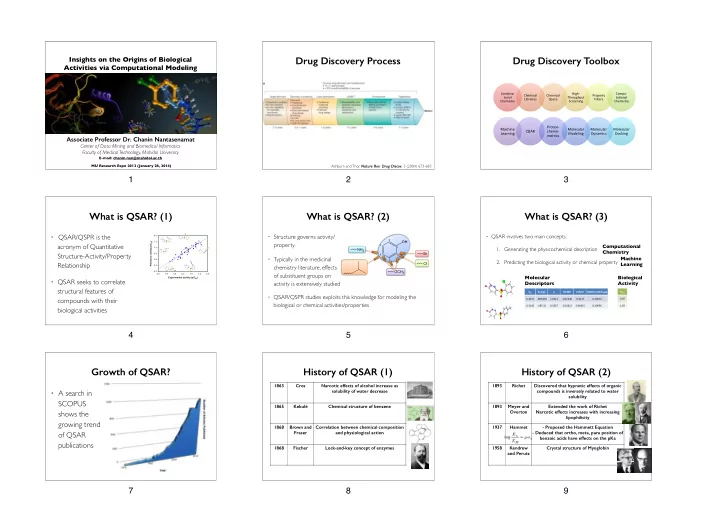

Drug Discovery Process Drug Discovery Toolbox Insights on the Origins of Biological Activities via Computational Modeling Combina( High( Compu( Chemical, Chemical, Property, torial, Throughput, ta;onal, Libraries, Space, Filters, Chemistry, Screening, Chemistry, Proteo3 Machine( Molecular( Molecular( Molecular( QSAR( chemo3 Learning( Modeling( Dynamics( Docking( metrics( Associate Professor Dr. Chanin Nantasenamat Center of Data Mining and Biomedical Informatics ! Faculty of Medical Technology, Mahidol University E-mail: chanin.nan@mahidol.ac.th MU Research Expo 2013 (January 28, 2014) Ashburn and Thor. Nature Rev. Drug Discov. 3 (2004) 673-683 1 2 3 What is QSAR? (1) What is QSAR? (2) What is QSAR? (3) • ! QSAR/QSPR is the • Structure governs activity/ • QSAR involves two main concepts: ! 8.0 6" Predicted activity (pIC 50 ) 7.5 property ! acronym of Quantitative Computational 5" 1" 1. Generating the physicochemical description ! 7.0 Chemistry Structure-Activity/Property 6.5 4" 2" • Typically in the medicinal Machine ! 3" 6.0 2. Predicting the biological activity or chemical property Relationship ! Learning chemistry literature, effects 5.5 5.0 5.0 5.5 6.0 6.5 7.0 7.5 8.0 of substituent groups on Molecular Biological Experimental activity (pIC 50 ) • QSAR seeks to correlate activity is extensively studied Descriptors Activity structural features of Q m# Energy# μ# HOMO# LUMO# HOMO0LUMO#gap# IC 50% • QSAR/QSPR studies exploits this knowledge for modeling the compounds with their 0.2271& '309.834& 1.0521& '0.21346& '0.0127& 0.20076& 0.05$ biological or chemical activities/properties 0.2142& '195.31& 0.2337& '0.22611& '0.01915& 0.20696& 1.50$ biological activities 4 5 6 Growth of QSAR? History of QSAR (1) History of QSAR (2) 1863 Cros Narcotic effects of alcohol increase as 1893 Richet Discovered that hypnotic effects of organic • A search in solubility of water decrease compounds is inversely related to water solubility SCOPUS 1865 Kekulé Chemical structure of benzene 1893 Meyer and Extended the work of Richet Overton Narcotic effects increases with increasing shows the lipophilicity growing trend 1868 Brown and Correlation between chemical composition 1937 Hammet - Proposed the Hammett Equation Fraser and physiological action - Deduced that ortho, meta, para position of of QSAR benzoic acids have effects on the pKa publications 1868 Fischer Lock-and-key concept of enzymes 1958 Kendrew Crystal structure of Myoglobin and Perutz 7 8 9
History of QSAR (3) History of QSAR (4) Applications of QSAR/QSPR models 1964 Hansch and - Hansch Analysis 1988 Cramer Introduced Comparative Molecular Field Fujita - Several physicochemical properties are Analysis (CoMFA) or what is to be known as • ! Regulatory Use: QSAR for modelling environmental combined in one equation 3D-QSAR 1997 Lipinski -Introduced the Rule of 5 for estimating drug toxicity/chemical hazards by EPA and OECD ! - Extended the earlier work of Hansch and absorption as well as assess drug-likeness Muir on plant growth regulators -Insufficient uptake if MW > 500 Da, LogP > 5, 1964 Free and - The concept is easy and no physico- H-bond donor > 5, H-bond acceptor > 10 • ! Drug Design: QSAR for modelling biological activities ! Wilson chemical properties were needed 1999 Oprea -Introduced Oprea’s criteria for lead-likeness - Postulated that the biological activity is a function of its substituent at different • ! Materials Design: QSPR for modelling chemical positions in a molecule 2001 Wikberg - Developed Proteochemometrics (so- 1977 Karplus Molecular Dynamics of Bovine Pancreatic properties called Multi-Target QSAR) Trypsin Inhibitor protein - Can be applied at the Proteome level 1985 Wuthrich NMR structure of BPT1 protein 2003 Congreve - Introduced Rule of 3 for fragment-likeness 10 11 12 Text$ Big Picture of the QSAR Process Procedures of QSAR Modeling Mining$ Copper$ Monte$Carlo$ Complex $ Feature$$ EDTA?$ SelecDon$ -5.2E+02 9.0E+01 1.3E+03 7.5E+02 -3.2E+00 Connec&vity+ DPPC$ -5.6E-04 9.2E-05 -4.2E-03 3.1E+00 1.2E+01 Geometrical+ Biological(Ac*vity( Topological+ of(Compound( LPS$ 9.1E+00 7.8E+00 -3.4E-01 -3.0E-04 -6.5E-11 Series( Charge+ Sulfonamide$ GETAWAY+ Template?$ Molecular Descriptors ! WHIM+ Experimental( Chemical( Bacitracin $ Molecular AnDmalarial $ Monomer$ Valida*on( Structures( 2D+autocorrela&on+ Structure ! Quantum+Chemical+ Phenol $ QSAR $ BPA $ MLR+ PLS+ Normaliza&on+ SVM+ Standardiza&on+ Vasorelaxant$ PCP $ AnD?H1N1 $ NN+ Sta*s*cal( Geometry( Assessment( Op*miza*on( PCA+ Furin $ GFP $ Vitamin$E$ Model Generation ! Data Pre-processing ! SOM+ KNN+ Aromatase$ Quorum $ DNA $ DT+ Inhibitors $ CYP450$ Machine(Learning( Molecular( Algorithm( Descriptors( Inhibitors$ Prediction ! Nantasenamat et al. EXCLI J. (2009) 8: 74-88 13 14 15 Biological activity/chemical property Biological Activity Requirements for compounds modeled by QSAR Biological Activity Chemical Property • Biological activity of compounds of interest are available from: ! • Compounds belong to a congeneric series ! Bioconcentration Boiling point Biodegradation Chromatographic retention time • Open Innovation ! • Primary literature ! Carcinogenicity Dielectric constant • Compounds exert the same mechanism of action ! Drug metabolism Diffusion coefficient • Pharmaceutical companies • Curated Databases ! Inhibitor constant Dissociation constant • Compounds bind in a comparable manner are making data publicly Mutagenicity Melting point • BindingDB ! available for non- Permeability ! Reactivity commercial diseases Blood brain barrier ! Solubility • MOAD ! Skin Stability ! Pharmacokinetics Thermodynamic properties • PubChem Receptor binding Viscosity Nantasenamat et al. EXCLI J. (2009) 8: 74-88 16 17 18
Chemical Structures (1) Chemical Structures (2) Chemical Structures (3) IUPAC 6-phenylsulfonylpyridazin-2H-3-one SMILES Clc1ccccc1S(=O)(=O)c1ccc(=O)[nH]n1 2D H O N N Cl O S O 3D Nantasenamat et al. Expert Opin. Drug Discov. (2010) 5: 633-654 Nantasenamat et al. Expert Opin. Drug Discov. (2010) 5: 633-654 19 20 21 Computational Chemistry (1) Computational Chemistry (2) Computational Chemistry (3) Potential Energy Surface Scan Nantasenamat et al. Conformational Study of Anastrozole. Unpublished Findings Nantasenamat et al. Expert Opin. Drug Discov. (2010) 5: 633-654 Nantasenamat et al. Expert Opin. Drug Discov. (2010) 5: 633-654 22 23 24 Molecular Descriptors (1) Molecular Descriptors (2) Molecular Descriptors (3) Nantasenamat et al. Expert Opin. Drug Discov. (2010) 5: 633-654 Nantasenamat et al. Expert Opin. Drug Discov. (2010) 5: 633-654 25 26 27
Recommend
More recommend